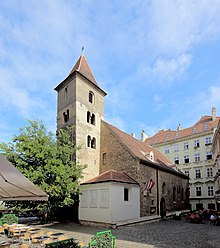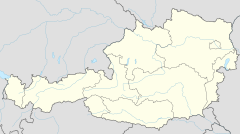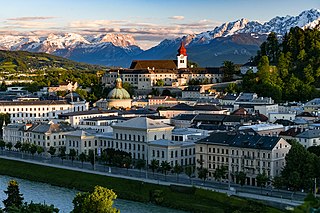
Salzburg is the fourth-largest city in Austria. In 2020, it had a population of 156,852.

Rose window is often used as a generic term applied to a circular window, but is especially used for those found in Gothic cathedrals and churches. The windows are divided into segments by stone mullions and tracery. The term rose window was not used before the 17th century and comes from the English flower name rose.

Leopold III, known as Leopold the Good, was the Margrave of Austria from 1095 to his death in 1136. He was a member of the House of Babenberg. He was canonized on 6 January 1485 and became the patron saint of Austria, Lower Austria, Upper Austria and Vienna. His feast day is 15 November.
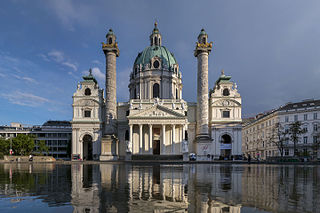
The Rektoratskirche St. Karl Borromäus, commonly called the Karlskirche, is a Baroque church located on the south side of Karlsplatz in Vienna, Austria. Widely considered the most outstanding baroque church in Vienna, as well as one of the city's greatest buildings, the church is dedicated to Saint Charles Borromeo, one of the great counter-reformers of the sixteenth century.

The Votivkirche is a neo-Gothic style church located on the Ringstraße in Vienna, Austria. Following the attempted assassination of Emperor Franz Joseph in 1853, the Emperor's brother Archduke Ferdinand Maximilian inaugurated a campaign to create a church to thank God for saving the Emperor's life. Funds for construction were solicited from throughout the Empire. The church was dedicated in 1879 on the silver anniversary of Emperor Franz Joseph and his wife Empress Elisabeth.

The Jesuit Church, also known as the University Church, is a two-floor, double-tower church in Vienna, Austria. Influenced by early Baroque principles, the church was remodeled by Andrea Pozzo between 1703 and 1705. The Jesuit Church is located on Dr. Ignaz Seipel-Platz, immediately adjacent to the old University of Vienna buildings.
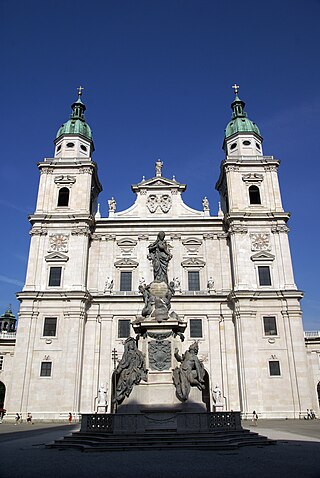
Salzburg Cathedral is the seventeenth-century Baroque cathedral of the Roman Catholic Archdiocese of Salzburg in the city of Salzburg, Austria, dedicated to Saint Rupert and Saint Vergilius. Saint Rupert founded the church in 774 on the remnants of a Roman town, and the cathedral was rebuilt in 1181 after a fire. In the seventeenth century, the cathedral was completely rebuilt in the Baroque style under Prince-Bishop Wolf Dietrich von Raitenau to its present appearance. Salzburg Cathedral still contains the baptismal font in which composer Wolfgang Amadeus Mozart was baptized.

Romanesque art is the art of Europe from approximately 1000 AD to the rise of the Gothic style in the 12th century, or later depending on region. The preceding period is known as the Pre-Romanesque period. The term was invented by 19th-century art historians, especially for Romanesque architecture, which retained many basic features of Roman architectural style – most notably round-headed arches, but also barrel vaults, apses, and acanthus-leaf decoration – but had also developed many very different characteristics. In Southern France, Spain, and Italy there was an architectural continuity with the Late Antique, but the Romanesque style was the first style to spread across the whole of Catholic Europe, from Sicily to Scandinavia. Romanesque art was also greatly influenced by Byzantine art, especially in painting, and by the anti-classical energy of the decoration of the Insular art of the British Isles. From these elements was forged a highly innovative and coherent style.
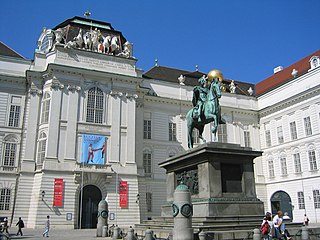
Josefsplatz is a public square located at the Hofburg Palace in Vienna, Austria. Named after Emperor Joseph II, Josefsplatz is considered one of the finest courtyards in Vienna.

The Augustinian Church in Vienna is a parish church located on Josefsplatz, next to the Hofburg, the winter palace of the Habsburg dynasty in Vienna. Originally built in the 14th century as the parish church of the imperial court of the Habsburgs, the harmonious Gothic interior was added in the 18th century. The official name of church and parish is St. Augustin, but it is locally called Augustinerkirche.

Maria am Gestade is a Gothic church in Vienna, Austria. One of the oldest churches in the city—along with St. Peter's Church and St. Rupert's Church—it is one of the few surviving examples of Gothic architecture in Vienna. Located in the Innere Stadt at Salvatorgasse 12, near the Donaukanal, the church was traditionally used by sailors on the Danube river. The name reflects the former location on the Fluvial terrace of an arm of the Danube river, prior to its regulation.
Due to the stairs surrounding the church it got the popular name Maria Stiegen.

Nonnberg Abbey is a Benedictine monastery in Salzburg, Austria. Founded c. 712/715 by Saint Rupert of Salzburg, it is the oldest continuously existing nunnery in the German-speaking world. The monastery complex is today a protected monument and part of the Historic Centre of the City of Salzburg, a UNESCO World Heritage Site since 1996.
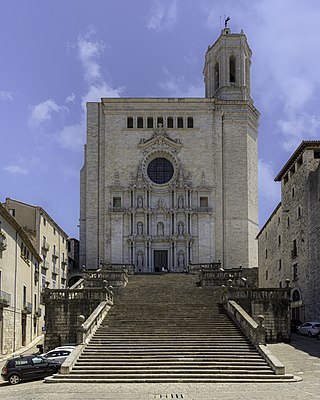
The Cathedral of Saint Mary,, is a Roman Catholic cathedral located in Girona, Catalonia, Spain. It is the seat of the Roman Catholic Diocese of Girona.

Saint Michael's Church is one of the oldest churches in Vienna, Austria, and also one of its few remaining Romanesque buildings. Dedicated to the Archangel Michael, St. Michael's Church is located at Michaelerplatz across from St. Michael's Gate at the Hofburg Palace. St. Michael's used to be the parish church of the Imperial Court, when it was called Zum heiligen Michael.

The Basilica of Saints Nazarius and Celsus is a Roman Catholic minor basilica located in the citadel of Carcassonne, France. It is a national monument, and is in the Gothic-Romanesque architectural tradition.
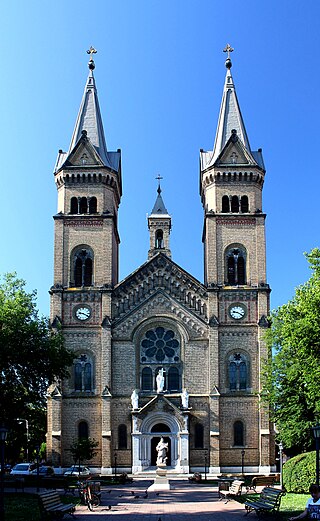
The Millennium Church, officially known as the Church of the Blessed Virgin Mary, Queen of Heaven, is the largest Roman Catholic church in Timișoara, located in the Romans' Square in the Fabric district. It was built to commemorate 1,000 years since the formation of the Hungarian state, hence its name Millennium. At present, Holy Masses are celebrated in Hungarian, German, Romanian and every Saturday evening in Italian.

The Church of Saint-Léon-de-Westmount is a Roman Catholic church located in Westmount, Quebec at 4311 De Maisonneuve Boulevard West. Built in 1901, the church was designed by well known Montreal architect Georges-Alphonse Monette and decorated by Guido Nincheri from 1901 to 1903, using the wet plaster buon fresco technique. Designed in the Romanesque Revival style, and featuring an Italianate façade with bell tower, the Church of Saint-Léon-de-Westmount was designated a National Historic Site of Canada in 1997 and plaqued in 1999.

The St. Canisius's Church is a Roman Catholic parish church in the 9th District of Vienna, Alsergrund.
Art Nouveau temples are churches, chapels, synagogues, and mosques built in the style known as Art Nouveau in French and English languages, Jugendstil in Germany and Nordic countries, Secessionsstil in countries of former Austro-Hungary, Modernisme in Catalan, Modern in Russian, Stile Liberty or Stile Floreale in Italian. As National Romantic style is also referred to Art Nouveau, churches of that style are also listed here, as well as some temples not of pure Art Nouveau style but with distinctive Art Nouveau features.

The Church of Saint Rupert is a Roman-Catholic parish church in the Schwanthalerhöhe district of Munich. It is named after Saint Rupert of Salzburg, chosen in honor of Rupprecht, Crown Prince of Bavaria.
